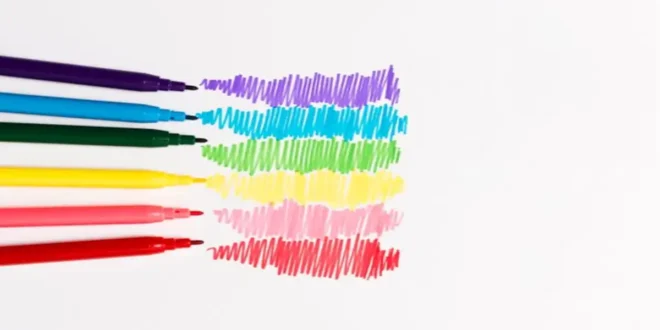The Ultimate Guide to Felt Tip Markers: History, Types, and Uses
Felt tip markers have become a staple in homes, offices, and classrooms worldwide. Known for their versatility and vivid colors, they serve various purposes, from artistic projects to educational activities and business presentations. In this article, we’ll dive deep into the world of felt tip markers, exploring their history, types, advantages, best uses, and tips for making the most out of them. By the end, you’ll gain a comprehensive understanding of why felt tip markers continue to be popular and how they can be used creatively and effectively.
1. What is a Felt Tip Marker?
A felt tip marker, commonly called a “marker pen” or simply “marker,” is a type of pen that uses a fibrous, absorbent tip to deliver ink. Unlike traditional pens with metallic or ballpoint tips, felt tip markers offer a broader, softer writing or drawing experience. The unique design of the felt tip allows for smooth, vibrant lines, making these markers ideal for both artwork and everyday writing.
2. History of Felt Tip Markers
The origin of felt tip markers can be traced back to the 1940s and 1950s. While writing and drawing tools existed long before, felt-tip technology was innovative. Below is a brief history of how felt tip markers evolved:
- 1940s-1950s: The first felt tip marker was introduced in Japan. It was primarily used for labeling and drafting.
- 1960s: The American brand Sanford introduced the Sharpie marker, which quickly gained popularity. Its durable felt tip and waterproof ink made it highly useful for various tasks.
- 1980s-1990s: Felt tip markers diversified in terms of color, shape, and use. Highlighter markers, permanent markers, and art markers became widely available.
- Modern Day: Today, felt tip markers are available in an array of colors, sizes, and types. They’re used globally for various applications, from professional artwork to everyday writing and organization tasks.
3. Types of Felt Tip Markers
There are many types of felt tip markers on the market, each tailored to specific tasks. Here’s a breakdown of the primary categories:
a) Permanent Markers
Permanent markers contain indelible ink that can write on most surfaces, including paper, plastic, glass, and metal. They are waterproof and resistant to fading, making them ideal for labeling items that need to withstand the elements.
b) Washable Markers
Washable markers are commonly used by children and artists who prefer non-permanent options. They are water-based, making them easy to wash off from skin and clothes.
c) Highlighter Markers
These markers feature translucent, bright colors designed to highlight text without obscuring it. Highlighters are perfect for studying, allowing users to emphasize important sections of text.
d) Art Markers
Art markers are often alcohol-based and come in a wide range of colors. They are popular among artists for their blendability and smooth application on various surfaces.
e) Dry Erase Markers
Used primarily on whiteboards, dry erase markers have a special ink that can be easily erased from non-porous surfaces. They are a go-to tool for presentations, brainstorming sessions, and temporary notes.
f) Scented Markers
Scented markers are infused with fragrances, adding a sensory dimension to drawing and writing. They are popular among young students and can make learning activities more engaging.
4. Advantages of Using Felt Tip Markers
Felt tip markers bring several benefits over traditional pens and pencils. Here are a few reasons why they’re favored in various settings:
- Vivid Colors: Felt tip markers provide vibrant, saturated colors, making them ideal for art, design, and note-taking.
- Smooth Application: The absorbent felt tip allows for a seamless, consistent flow of ink, creating smooth lines and even coverage.
- Versatility: These markers are suitable for different materials, including paper, fabric, plastic, and glass, depending on the ink type.
- Variety of Tip Sizes: Felt tip markers come in a range of tip sizes, from ultra-fine to broad, allowing for precision or bold lines as needed.
- Quick Drying: Many felt tip markers have fast-drying ink, reducing smudging, especially on glossy or non-porous surfaces.
5. Best Practices for Using Felt Tip Markers
To get the best results from your felt tip markers, here are some tips to follow:
a) Store Them Properly
Felt tip markers should be stored horizontally to prevent the ink from drying out or pooling on one side. This ensures an even flow of ink when you use them.
b) Use on Appropriate Surfaces
While permanent markers can work on almost any surface, others, like washable markers, are best suited for paper. Be mindful of the surface compatibility of each marker to avoid disappointment.
c) Replace Caps After Use
Markers dry out quickly if left uncapped. Always replace the cap after use to extend the lifespan of your markers.
d) Apply Light Pressure
Pressing too hard can damage the felt tip, leading to fraying and uneven ink flow. Use a light hand to preserve the tip’s shape and longevity.
6. Creative Uses of Felt Tip Markers
Felt tip markers are not just for writing; they open up a world of creative possibilities. Here are some inventive ways to use them:
a) Illustrations and Artwork
Artists love Types of markers for their blendability and range of colors. With different marker types, artists can create depth, shading, and vibrant details in their illustrations.
b) DIY and Craft Projects
From decorating mugs to personalizing t-shirts, Types of markers are ideal for DIY projects. Permanent markers can make long-lasting designs on ceramics, glass, and fabric.
c) Calligraphy and Lettering
Brush tip markers, a type of Types of markers, are commonly used for calligraphy. The flexible tip mimics traditional calligraphy brushes, making it easy to create beautiful script and stylized lettering.
d) Organizing and Labeling
Types of markers can be used for color-coded labeling, making it easier to organize items in the home, office, or classroom. Highlighters are excellent for emphasizing important information in documents.
e) Study Aid
Students can benefit from Types of markers to make notes and highlight key information. Bright colors help in retaining information, making studying more effective.
7. How to Choose the Right Felt Tip Marker
Selecting the right Types of markers depends on the intended use. Here’s a guide to choosing the best marker for specific needs:
- For Artwork: Look for alcohol-based art markers with a wide color range and blendability.
- For Note-Taking: Opt for Types of markers with quick-drying ink to avoid smudging on paper.
- For Presentations: Choose dry erase markers that are easily erasable and bright enough to be visible from a distance.
- For Kids: Go with washable markers that can be easily cleaned from surfaces and skin.
8. Environmental Impact of Felt Tip Markers
With growing concerns about environmental sustainability, it’s essential to consider the ecological impact of felt tip markers. Here are some points to consider:
- Plastic Waste: Most Types of markers are made with plastic casings, which can contribute to plastic waste if not disposed of properly.
- Chemical Ink: Some markers, especially permanent and alcohol-based markers, use inks with solvents that are not environmentally friendly.
- Eco-Friendly Options: Many manufacturers now offer eco-friendly markers made from recycled materials or refillable options to reduce waste.
9. Caring for Your Felt Tip Markers
Proper care can extend the lifespan of your markers, ensuring you get the most out of them:
a) Keep Them in a Cool, Dry Place
Excessive heat can dry out the ink, while humidity can affect the ink’s consistency.
b) Avoid Rough Surfaces
Using markers on rough surfaces can damage the felt tip, making it fray and lose its smooth application.
c) Regular Cleaning
For markers that tend to dry out, try dipping the tip in a few drops of rubbing alcohol to refresh the ink flow.
10. Top Felt Tip Marker Brands
Several brands are known for their quality Types of markers. Here are some top choices among professionals and enthusiasts:
- Sharpie: Known for their durable permanent markers, Sharpie offers a range of markers that work on various surfaces.
- Copic: A popular brand among artists, Copic markers are alcohol-based and highly blendable.
- Crayola: Known for their washable markers, Crayola is ideal for children and beginners.
- Staedtler: This brand offers fine tip markers perfect for technical drawings and note-taking.
- Tombow: Tombow brush markers are popular in the calligraphy world due to their flexible tips.
Conclusion
Felt tip markers are versatile tools that have carved out their place in our everyday lives, from art to organization and beyond. Understanding the types, best practices, and creative applications of these markers can help you make the most of them. Whether you’re an artist, student, or professional, there’s a felt tip marker out there tailored to your needs. By caring for them properly and choosing the right type for each task, you can ensure they’ll serve you well for a long time. So go ahead, explore the world of Types of markers and let your creativity flow!
Frequently Asked Questions (FAQs)
What surfaces can I use felt tip markers on?
Felt tip markers are versatile and can be used on various surfaces, depending on the type of marker. Permanent markers work well on most materials, including glass, plastic, metal, and paper. Washable markers, however, are best suited for paper and other porous surfaces, while dry erase markers are designed for non-porous surfaces like whiteboards.
How can I make my felt tip markers last longer?
To extend the life of Types of markers, always cap them tightly after use, store them horizontally, and avoid pressing too hard on the tip. For markers that tend to dry out quickly, especially fine-tip varieties, storing them in a cool, dry place and using light pressure can make them last longer.
Are felt tip markers safe for children to use?
Yes, most Types of markers, especially washable and non-toxic varieties, are safe for children. Always check labels to ensure the markers are labeled as non-toxic and child-safe. Washable markers are particularly ideal for kids, as they’re easy to clean off skin and clothing.
Can you revive a dried-out felt tip marker?
Yes, in some cases, dried-out markers can be revived. Try dipping the tip in a few drops of rubbing alcohol or warm water, which can help rehydrate the ink. This trick works especially well for markers that have water or alcohol-based inks, like highlighters and art markers.
What’s the best way to store felt tip markers?
For best results, store Types of markers horizontally in a cool, dry place. This positioning helps distribute the ink evenly and prevents it from drying out on one end. If you’re working with dual-tip markers, horizontal storage is particularly important to ensure both tips stay functional.
What’s the difference between permanent markers and regular felt tip markers?
Permanent markers use indelible ink that adheres to most surfaces and resists water and fading, while regular felt tip markers may use water-based inks that are more suited to paper and temporary uses. Permanent markers are ideal for labeling and creating lasting designs, whereas regular Types of markers are better for general writing, coloring, and indoor use.
READ ALSO:The Ultimate Guide to L-Shaped Desks: A Practical, Stylish Solution for Modern Workspaces
 Touch Blog
Touch Blog



